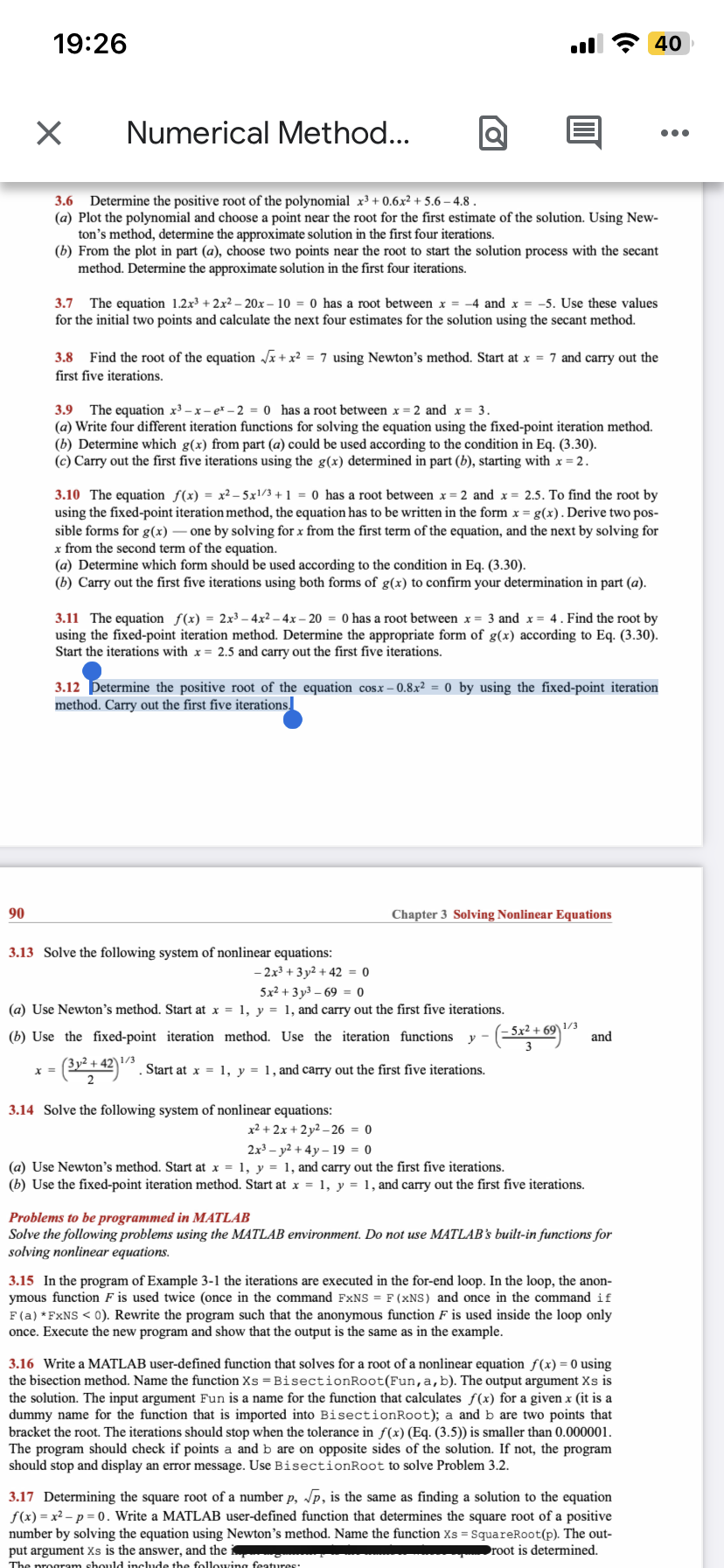Linear Algebra: A Modern Introduction
4th Edition
ISBN:9781285463247
Author:David Poole
Publisher:David Poole
Chapter2: Systems Of Linear Equations
Section2.5: Iterative Methods For Solving Linear Systems
Problem 27EQ
Related questions
Question
100%
3.12

Transcribed Image Text:90
19:26
X
Numerical Method...
3.6 Determine the positive root of the polynomial x³ +0.6x² +5.6-4.8.
(a) Plot the polynomial and choose a point near the root for the first estimate of the solution. Using New-
ton's method, determine the approximate solution in the first four iterations.
(b) From the plot in part (a), choose two points near the root to start the solution process with the secant
method. Determine the approximate solution in the first four iterations.
3.7 The equation 1.2x³ + 2x²-20x-10 = 0 has a root between x = -4 and x = -5. Use these values
for the initial two points and calculate the next four estimates for the solution using the secant method.
3.8 Find the root of the equation √x + x² = 7 using Newton's method. Start at x = 7 and carry out the
first five iterations.
3.9 The equation x³-x-et-2 = 0 has a root between x = 2 and x = 3.
(a) Write four different iteration functions for solving the equation using the fixed-point iteration method.
(b) Determine which g(x) from part (a) could be used according to the condition in Eq. (3.30).
(c) Carry out the first five iterations using the g(x) determined in part (b), starting with x = 2.
3.10 The equation f(x) = x²-5x1/3 + 1 = 0 has a root between x=2 and x = 2.5. To find the root by
using the fixed-point iteration method, the equation has to be written in the form x = g(x). Derive two pos-
sible forms for g(x) - one by solving for x from the first term of the equation, and the next by solving for
x from the second term of the equation.
(a) Determine which form should be used according to the condition in Eq. (3.30).
(b) Carry out the first five iterations using both forms of g(x) to confirm your determination in part (a).
3.11 The equation f(x) = 2x³-4x² - 4x-20 = 0 has a root between x = 3 and x = 4. Find the root by
using the fixed-point iteration method. Determine the appropriate form of g(x) according to Eq. (3.30).
Start the iterations with x = 2.5 and carry out the first five iterations.
3.12 Determine the positive root of the equation cosx-0.8x² = 0 by using the fixed-point iteration
method. Carry out the first five iterations.
3.13 Solve the following system of nonlinear equations:
-2x³+3y² +42 = 0
5x² + 3y³-69 = 0
(a) Use Newton's method. Start at x = 1, y = 1, and carry out the first five iterations.
(b) Use the fixed-point iteration method. Use the iteration functions y
x = (³x² + 42) 1/³. Start at x = 1, y = 1, and carry out the first five iterations.
3.14 Solve the following system of nonlinear equations:
Chapter 3 Solving Nonlinear Equations
x²+2x+2y²-26= 0
40
- (-5x3+69) 13
2x³y2 + 4y - 19 = 0
(a) Use Newton's method. Start at x = 1, y = 1, and carry out the first five iterations.
(b) Use the fixed-point iteration method. Start at x = 1, y = 1, and carry out the first five iterations.
and
Problems to be programmed in MATLAB
Solve the following problems using the MATLAB environment. Do not use MATLAB's built-in functions for
solving nonlinear equations.
3.15 In the program of Example 3-1 the iterations are executed in the for-end loop. In the loop, the anon-
ymous function F is used twice (once in the command FxNS = F (xNS) and once in the command if
F (a) *FxNS < 0). Rewrite the program such that the anonymous function F is used inside the loop only
once. Execute the new program and show that the output is the same as in the example.
3.16 Write a MATLAB user-defined function that solves for a root of a nonlinear equation f(x) = 0 using
the bisection method. Name the function Xs - BisectionRoot(Fun, a, b). The output argument Xs is
the solution. The input argument Fun is a name for the function that calculates f(x) for a given x (it is a
dummy name for the function that is imported into BisectionRoot); a and b are two points that
bracket the root. The iterations should stop when the tolerance in f(x) (Eq. (3.5)) is smaller than 0.000001.
The program should check if points a and b are on opposite sides of the solution. If not, the program
should stop and display an error message. Use BisectionRoot to solve Problem 3.2.
3.17 Determining the square root of a number p, √p, is the same as finding a solution to the equation
f(x)=x²-p=0. Write a MATLAB user-defined function that determines the square root of a positive
number by solving the equation using Newton's method. Name the function Xs = SquareRoot(p). The out-
put argument xs is the answer, and the
root is determined.
The program should include the following features:
Expert Solution
This question has been solved!
Explore an expertly crafted, step-by-step solution for a thorough understanding of key concepts.
Step by step
Solved in 4 steps with 4 images

Recommended textbooks for you

Linear Algebra: A Modern Introduction
Algebra
ISBN:
9781285463247
Author:
David Poole
Publisher:
Cengage Learning

Algebra & Trigonometry with Analytic Geometry
Algebra
ISBN:
9781133382119
Author:
Swokowski
Publisher:
Cengage

College Algebra
Algebra
ISBN:
9781305115545
Author:
James Stewart, Lothar Redlin, Saleem Watson
Publisher:
Cengage Learning

Linear Algebra: A Modern Introduction
Algebra
ISBN:
9781285463247
Author:
David Poole
Publisher:
Cengage Learning

Algebra & Trigonometry with Analytic Geometry
Algebra
ISBN:
9781133382119
Author:
Swokowski
Publisher:
Cengage

College Algebra
Algebra
ISBN:
9781305115545
Author:
James Stewart, Lothar Redlin, Saleem Watson
Publisher:
Cengage Learning